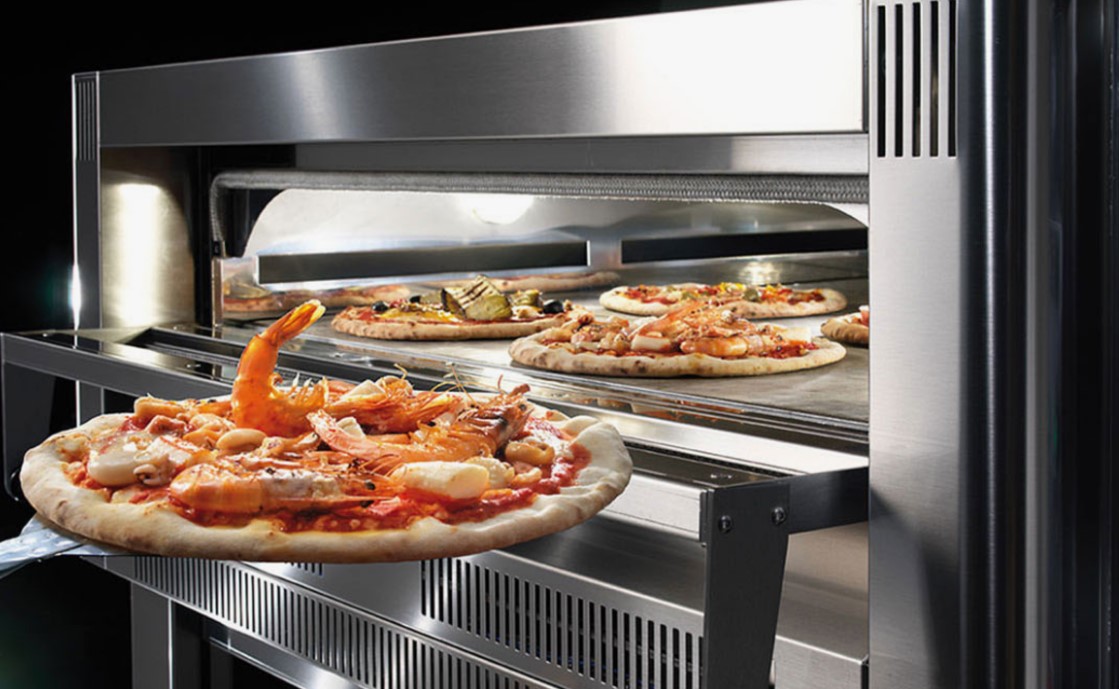Ingredient quality plays a significant role in pizza preparation, affecting not only flavor and texture but also the efficiency and performance of commercial pizza ovens. In professional kitchens, especially in Dubai and the UAE, where the demand for high-quality dining experiences is growing, understanding how ingredients interact with pizza ovens is essential. This article explores the influence of various ingredients—such as dough, sauce, cheese, and toppings—on oven performance and offers insights for restaurants seeking to optimize their baking processes.
The Role of Dough Quality in Oven Performance
Dough quality directly impacts how a pizza bakes in the oven. Doughs with higher water content, for example, can slow down baking times as they require more heat to evaporate the moisture. This can lead to uneven cooking and may affect the oven’s efficiency, as higher moisture levels create steam within the cooking chamber. For high-performance ovens, achieving a balance between hydration and dough elasticity is crucial. A well-prepared dough that aligns with the oven’s temperature settings ensures an evenly baked pizza, optimizing both texture and cooking time, which is essential in fast-paced kitchens.
Flour Types and Their Effects on Baking Efficiency
The type of flour used in pizza dough significantly affects baking efficiency and final product quality. Flours with higher protein content, such as bread flour, tend to absorb more water and yield a chewier crust, which may require slightly longer cooking times. Meanwhile, flours with lower protein, such as all-purpose or pastry flour, bake faster but may lack the desired texture for traditional pizzas. In Dubai, where diverse pizza styles are popular, selecting flour that complements the pizza oven’s specifications helps improve baking performance and maintain consistency across different pizza varieties.

Sauce Consistency and Oven Performance
The consistency and moisture level of pizza sauce can influence how a pizza bakes. Thicker sauces with reduced water content are preferable for faster baking, as they allow the dough to crisp up without soaking up excess moisture. Conversely, a watery sauce may prevent the dough from achieving the right crispiness and extend cooking time. For high-performance pizza ovens, using a sauce with the right viscosity enhances baking efficiency and ensures a consistent finish. In regions like the UAE, where premium ingredients are often expected, focusing on sauce quality can contribute to the overall efficiency of the pizza-making process.
Cheese Quality and Melting Behavior
The type and quality of cheese used on a pizza have a substantial effect on oven performance and the final product. Mozzarella, a common choice, varies in moisture and fat content, which can affect melting consistency. High-moisture mozzarella can lead to excess liquid on the pizza, potentially slowing down the baking process and impacting crust texture. On the other hand, low-moisture mozzarella promotes faster melting, allowing the pizza to cook evenly. Choosing cheese that matches the oven’s heat levels and cooking time ensures optimal melting, flavor release, and texture, making it an essential consideration for professional kitchens.
The Impact of Toppings on Cooking Dynamics
The type and quantity of toppings used on a pizza can alter cooking dynamics within a pizza oven. Toppings with high water content, such as vegetables, can release moisture during baking, which may soften the crust and affect baking times. Similarly, dense toppings like meats can slow down the cooking process, requiring additional time to reach the appropriate temperature. Balancing toppings in a way that complements the oven’s heat distribution ensures an evenly cooked pizza. In Dubai’s competitive dining scene, achieving this balance is crucial for maintaining quality and meeting customer expectations.
Temperature Control and Ingredient Quality
High-quality ingredients often respond differently to temperature, making control over oven settings crucial. For example, artisan doughs or premium cheeses may require precise temperature adjustments to preserve flavor and texture without overcooking. Consistent temperature control allows ingredients to react optimally within the oven, reducing variability and enhancing product quality. Advanced pizza ovens with programmable settings are particularly beneficial in managing ingredient variations, ensuring that each pizza meets expected standards. In UAE kitchens, where premium quality is a priority, precise temperature management supports the effective use of top-tier ingredients.
Ingredient Quality and Energy Efficiency in Ovens
The quality of ingredients can also impact the energy efficiency of pizza ovens. Doughs with lower hydration levels, for instance, require less heat and bake faster, reducing overall energy consumption. High-quality ingredients that bake efficiently align with the operating specifications of commercial ovens, enabling faster cooking and minimizing energy waste. For kitchens in Dubai and the UAE, where energy costs are a consideration, using ingredients that enhance oven performance can be an effective strategy for managing expenses while maintaining food quality. This approach supports efficient operation, especially in high-volume settings.

How Ingredient Texture Affects Baking Times
Texture is a critical aspect of ingredients that influences baking times and oven performance. Firmer doughs, cheeses with lower moisture, and crisp vegetables tend to bake faster and require less time to achieve the desired finish. In contrast, softer ingredients or those with high water content may need extended baking times to reach optimal texture. By selecting ingredients with the appropriate texture for the intended pizza style, chefs can improve baking consistency. In fast-paced environments, understanding these texture dynamics helps streamline operations and ensures consistent results, which is essential for customer satisfaction.
Importance of Preheating and Ingredient Consistency
Preheating the oven to the correct temperature ensures that ingredients bake uniformly, especially for doughs and sauces with varied moisture levels. High-quality ingredients often contain minimal preservatives and additives, which means they can respond differently to heat. Proper preheating allows ingredients to cook evenly from the outset, reducing the risk of underbaked sections. In commercial settings, consistent preheating combined with ingredient quality ensures efficiency in every bake. This consistency is key in Dubai’s restaurant market, where customer expectations for quality and speed are high.
Impact of Ingredient Temperature on Oven Performance
Ingredient temperature before baking also affects oven performance. Cold ingredients, such as refrigerated dough or cheese, can lower the oven’s internal temperature when introduced, which may extend cooking times. In professional kitchens, allowing ingredients to reach room temperature before baking can help maintain consistent heat levels within the oven, supporting efficient cooking. By controlling ingredient temperature, chefs in Dubai can achieve the ideal balance between speed and quality, ensuring pizzas are prepared to specification without compromising on oven efficiency.
Consistency in Ingredient Sourcing and Quality Control
Maintaining consistent ingredient quality is essential for optimizing pizza oven performance over time. Variations in flour, cheese, or sauce quality from different suppliers can lead to changes in baking dynamics, impacting both cooking time and texture. Establishing reliable sourcing and quality control practices allows restaurants to maintain steady performance with their ovens. In Dubai, where premium dining is a priority, consistent ingredient quality directly influences the customer experience, supporting a reputation for high standards and reliability in every meal.
The Role of Kitchen Layout in Enhancing Ingredient and Oven Performance
Kitchen layout can impact the interaction between ingredients and oven performance. For instance, placing prep areas close to the pizza oven minimizes the time between ingredient preparation and baking, ensuring fresher products and reducing temperature drops. In Dubai’s high-end kitchens, efficient layouts support both ingredient quality and oven effectiveness. By integrating prep stations with proximity to the oven, kitchens can streamline their workflows, enhance ingredient freshness, and achieve consistent results. This spatial arrangement ultimately supports the overall efficiency and productivity of commercial kitchens.
Kitchen Warehouse as a Source for Quality Pizza Equipment
For kitchens looking to optimize pizza oven performance, high-quality ingredients are just one part of the equation; sourcing reliable pizza equipment is also essential. Kitchen Warehouse offers a wide range of commercial pizza ovens that cater to diverse cooking requirements, helping restaurants achieve optimal baking performance. With equipment suited to various ingredient types and preparation methods, Kitchen Warehouse supports UAE businesses in their pursuit of excellence, ensuring that each pizza reaches its full potential in flavor, texture, and presentation.
Conclusion
Ingredient quality has a direct and measurable impact on commercial pizza oven performance, influencing baking times, energy efficiency, and product consistency. By understanding how various ingredients interact with heat, moisture, and cooking dynamics, restaurants can enhance their operations and produce consistently high-quality pizzas. In Dubai and the UAE, where culinary standards are increasingly focused on premium dining experiences, aligning ingredient selection with oven capabilities is essential for maintaining quality and customer satisfaction. As the region’s dining landscape evolves, ingredient quality will continue to play a critical role in the efficiency and success of pizza preparation.




